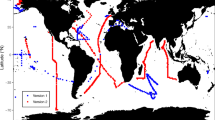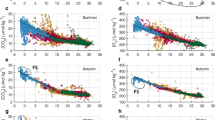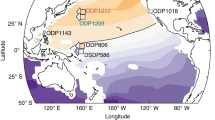Abstract
Waters that leave the surface of the ocean and enter the subsurface circulation contain concentrations of CCl3F (fluorocarbon-11) and CCl2F2 (fluorocarbon-12), which reflects the temporal increases of these industrially produced compounds in the atmosphere. These chlorofluoromethanes (CFMs) are extremely stable in the troposphere and in natural waters, they have no known natural sources, and their histories of release to the atmosphere are fairly well known1. The atmospheric distributions of CCl3F and CCl2F2 are not strongly dependent on latitude2,3, and their surface water concentrations can be expected to come into relatively rapid solubility equilibrium with the atmosphere4. Recent advances in analytical techniques5,6 have made possible the routine use of these CFMs as oceanic tracers on a decadal timescale. The results we report here are from the first detailed surveys of CCl3F and CCl2F2 distributions in the northern and tropical Atlantic Ocean. They show that CFM-bearing waters originating in the region of the Labrador Sea have reached the Equator in a well-defined western-boundary undercurrent located at a depth of about 1.6 km, in the Upper North Atlantic Deep Water. Using a simple dilution model, we calculate that this water has taken about 23 yr to reach the equatorial region, and has been diluted about five-fold by CFM-free waters.
This is a preview of subscription content, access via your institution
Access options
Subscribe to this journal
Receive 51 print issues and online access
$199.00 per year
only $3.90 per issue
Buy this article
- Purchase on Springer Link
- Instant access to full article PDF
Prices may be subject to local taxes which are calculated during checkout
Similar content being viewed by others
References
Halocarbons: Effects on Stratospheric Ozone (National Academy of Sciences, Washington, DC, 1976).
Cunnold, D. M. et al. J. geophys. Res. 88, 8379–8400 (1983).
Cunnold, D. M. et al. J. geophys. Res. 88, 8401–8414 (1983).
Broecker, W. S. & Peng, T.-H. Tellus 26, 21–35 (1974).
Gammon, R. H., Cline, J. & Wisegarver, D. J. geophys. Res. 87, 9441–9454 (1982).
Bullister, J. L. & Weiss, R. F. Science 221, 265–268 (1983).
Rasmussen, R. A. & Lovelock, J. E. J. geophys. Res. 88, 8369–8378 (1983).
Rasmussen, R. A. & Khalil, M. A. K. in Proc. NATO Advanced Study Inst. Atmospheric Ozone (ed. Aiken, A. C.) 209–231 (Federal Aviation Administration, Washington, DC, 1980).
Production, Sales and Calculated Release of Chlorofluorocarbons 11 and 12 through 1982 (Chemical Manufacturers Association, Washington, DC, 1983).
Molina, M. J. & Rowland, F. S. Nature 249, 810–812 (1974).
Wüst, G. Wiss. Ergebn. dt. atlant. Exped. ‘Meteor’ 6, 109–288 (1935).
Lynn, R. J. & Reid, J. L. Deep-Sea Res. 15, 577–598 (1968).
Millero, F. J., Chen, C.-T., Bradshaw, A. & Schleicher, K. Deep-Sea Res. 27A, 255–264 (1980).
Talley, L. D. & McCartney, M. S. J. phys. Oceanogr. 12, 1189–1205 (1982).
Weiss, R. F. & Price, B. A. Mar. Chem. 8, 347–359 (1980).
Author information
Authors and Affiliations
Rights and permissions
About this article
Cite this article
Weiss, R., Bullister, J., Gammon, R. et al. Atmospheric chlorofluoromethanes in the deep equatorial Atlantic. Nature 314, 608–610 (1985). https://doi.org/10.1038/314608a0
Received:
Accepted:
Issue Date:
DOI: https://doi.org/10.1038/314608a0
This article is cited by
-
Idealized tracer transport models with time-varying transport: applications to ocean boundary currents
Environmental Fluid Mechanics (2010)
-
Study of dissolved chlorofluorocarbons in Lake Washington
Chinese Journal of Oceanology and Limnology (2003)
-
The effects of a sloping bottom on the equatorial wave-induced deep residual currents
Chinese Journal of Oceanology and Limnology (1997)
-
Chlorofluorocarbon evidence for recent ventilation of the deep Bering Sea
Nature (1995)
Comments
By submitting a comment you agree to abide by our Terms and Community Guidelines. If you find something abusive or that does not comply with our terms or guidelines please flag it as inappropriate.



